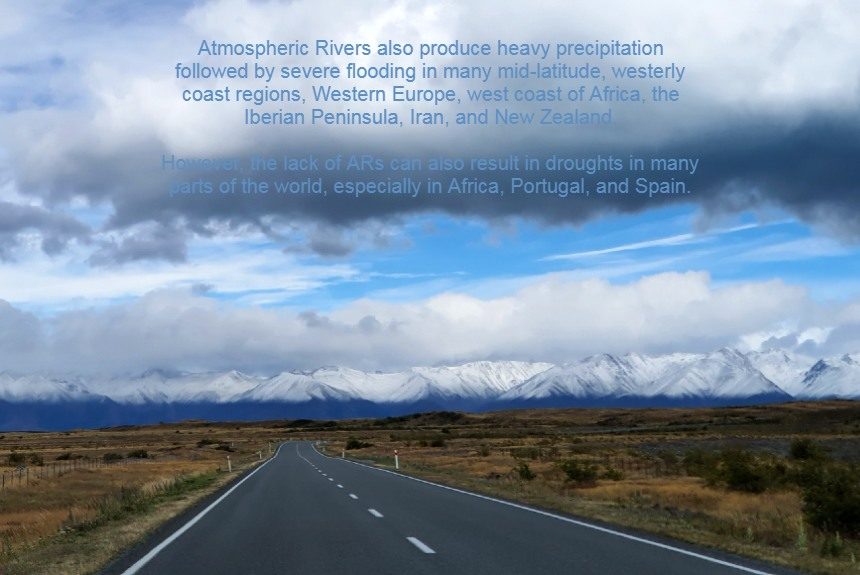If you think that rivers only exist on land, think again. Atmospheric rivers are rivers in the sky.
Atmospheric rivers (AR) are long and narrow bands of moisture in the atmosphere, much longer than the world’s longest river. They are usually 2000 kilometres long and about 800 kilometres wide.
A paper by the Geophysical Research Letter describes ARs as “long meandering plumes of water vapour often originating over the tropical oceans that bring sustained, heavy precipitation to the west coast of North America and northern Europe” (Curry, et al, 2019).
It also produces heavy precipitation followed by severe flooding in many mid-latitude, westerly coast regions, Western Europe, the west coast of Africa, the Iberian Peninsula, Iran, and New Zealand.
However, the lack of ARs can also result in droughts in many parts of the world, especially in Africa, Portugal, and Spain.
ARs can also be quite helpful. The precipitation and snow it generates can replenish water supplies. In California, AR accounts for half of its rainfall.
Link between Climate Change and Atmospheric Rivers
Recently, there has been a growing interest in studying Atmospheric Rivers and their links to floods, droughts, and economic losses.
In New Zealand, extreme rainfall from ARs has resulted in dangerous floods.
In March 2019, severe flooding damaged the Waiho River bridge. Auckland researchers found that atmospheric rains produced twice as much rainfall as their non-AR counterparts. It can also create three times as much rain in the West Coast and Northern New Zealand. The largest ARs detected in the country is around 1300 thousand kilometres long and about 1200 km wide, stretching from the South of Indonesia up to the Chatham Islands, well east of New Zealand (Harvie, 2021).
Researchers predict that AR’s impacts in the southern mid-land will be more severe and frequent as global temperatures increase.
In the United States, flood damages caused by atmospheric rivers amount to $51 billion over 40 years. Annually, the cost of damages averages $1 billion on the West coast. The region expects ARs to become wetter, longer, and broader because of climate change (Cowan, 2019).
Because of the socio-economic costs caused by extreme events, including AR events, there is a need to create models to predict the impacts of extreme events. Better forecast of ARs can also inform climate adaptation strategies to increase resilience and find ways to capture and store additional rainfall, improving water supply.
A Communications Earth and Environment study seeks to improve AR forecasting through a “comprehensive and systematic observational campaign”. ARs are not observed as much as any other natural events.
“With improved understanding of the physiography of river basins and insights into their flood response to extreme precipitation, the impacts of atmospheric rivers can also be forecast more reliably”, the study says.
To read the entire study, click the links in the “Sources” section below.
Sources:
Curry, C.L., Islam, S.U., Zwiers, F.W., & Dery, S.J. (2019 January 22). Atmospheric Rivers Increase Future Flood Risk in Western Canada’s Largest Pacific River. AGU Publishing. Retrieved from https://agupubs.onlinelibrary.wiley.com/doi/full/10.1029/2018GL080720
Harvie, W. (2021, January 25). ‘Atmospheric rivers’ drive New Zealand’s wet and extreme weather. Stuff. Retrieved from https://www.stuff.co.nz/science/123952985/atmospheric-rivers-drive-new-zealands-wet-and-extreme-weather
Cowan, J. (2019, December 5). How Much Damage Do Atmospheric Rivers Cause? The New York Times. Retrieved from https://www.nytimes.com/2019/12/05/us/atmospheric-rivers-damage.html
Lavers, D.A., Ralph, F.M., Richardson, D.S. et al. Improved forecasts of atmospheric rivers through systematic reconnaissance, better modelling, and insights on conversion of rain to flooding. Commun Earth Environ 1, 39 (2020). https://doi.org/10.1038/s43247-020-00042-1



Leave a Reply